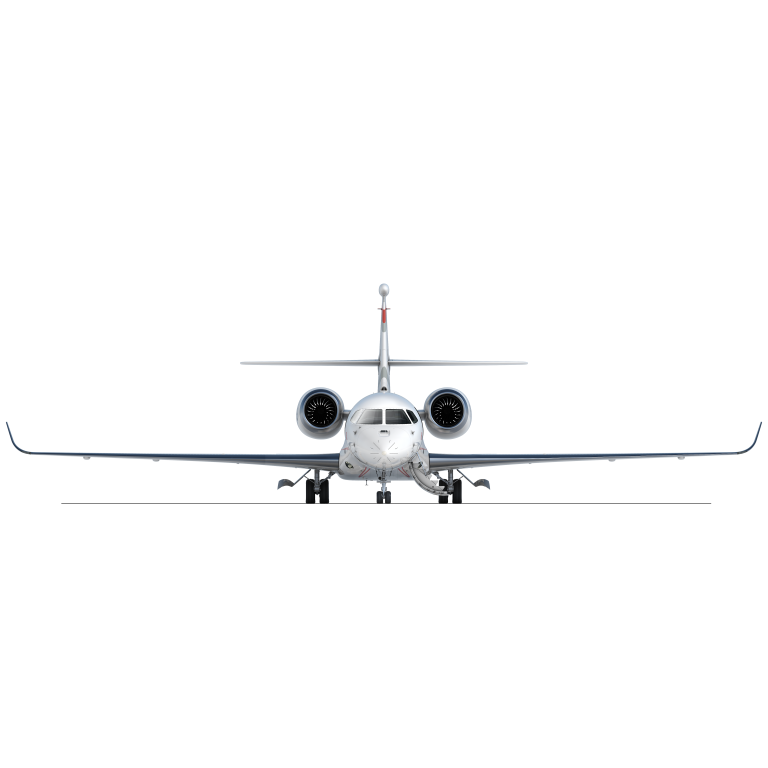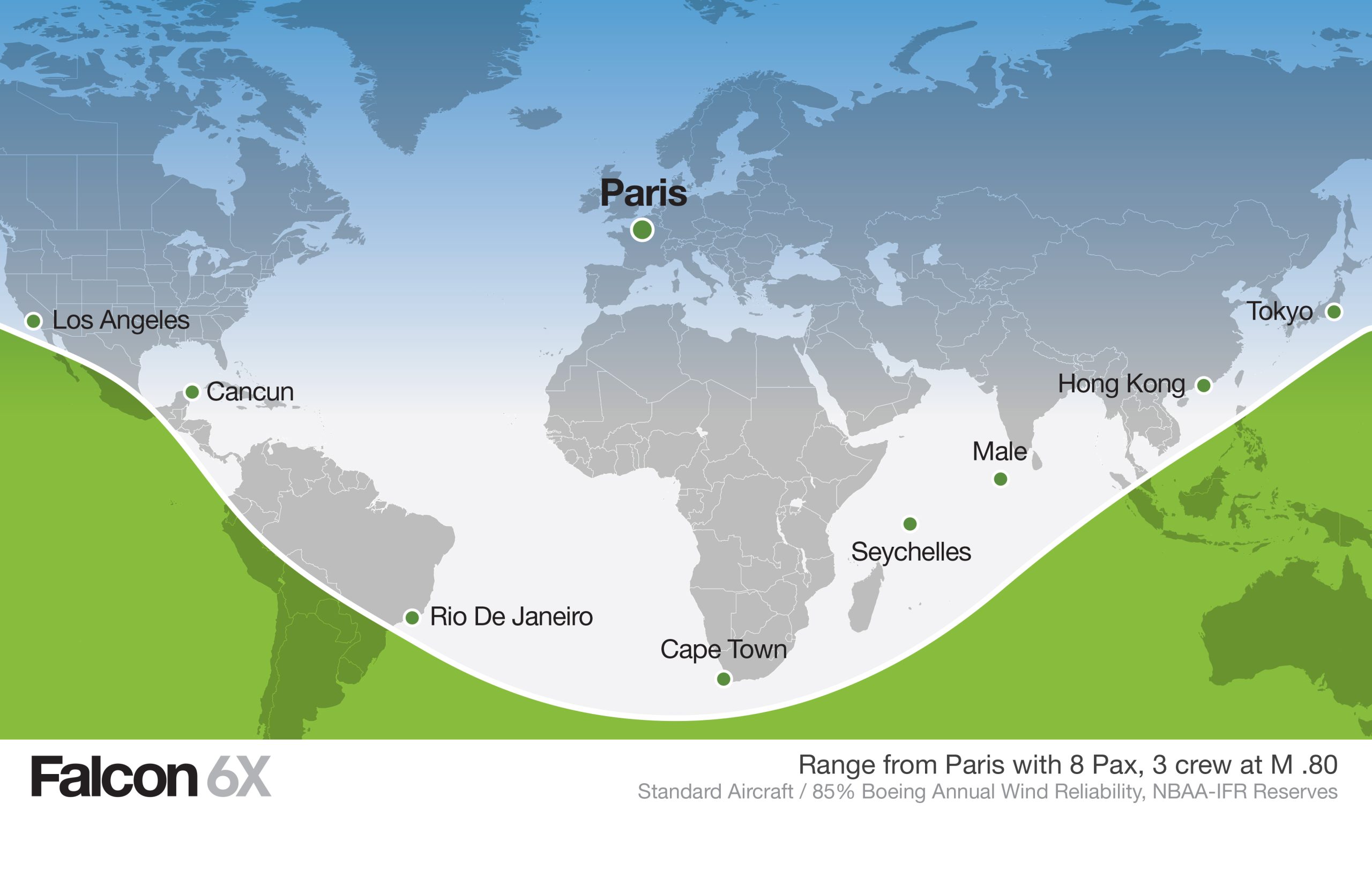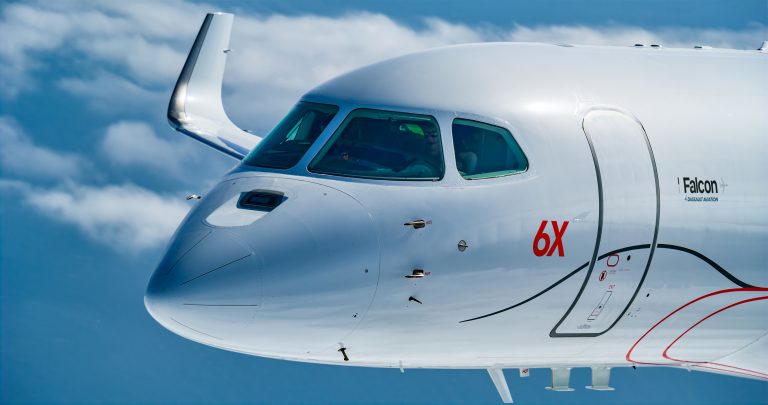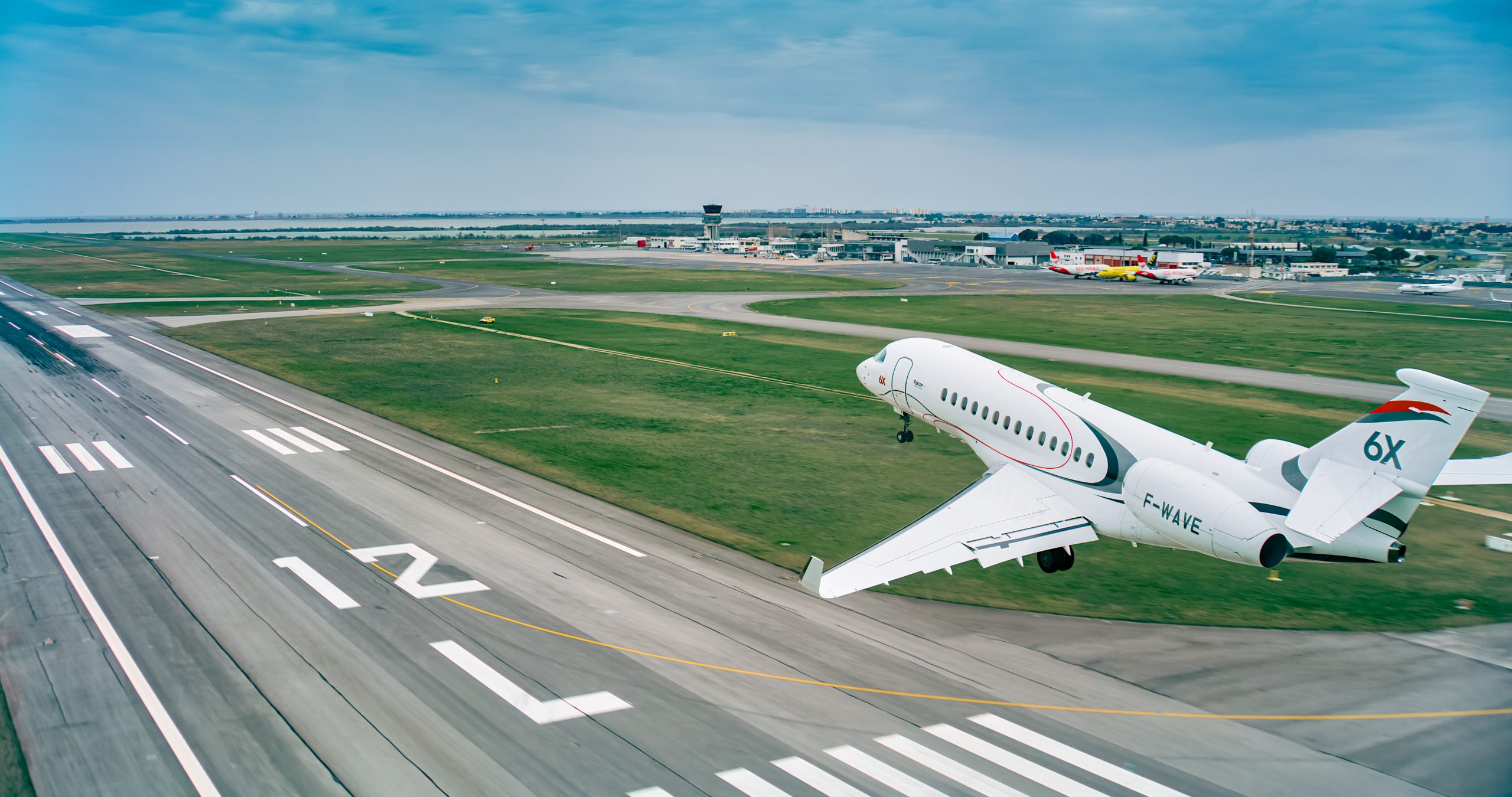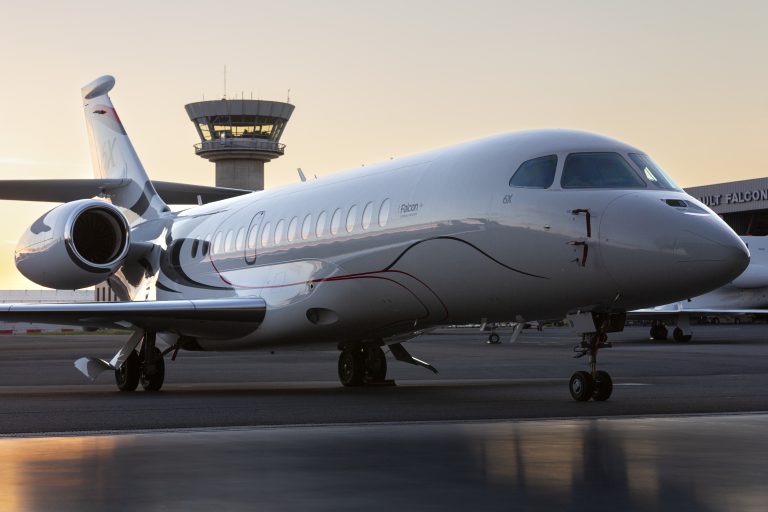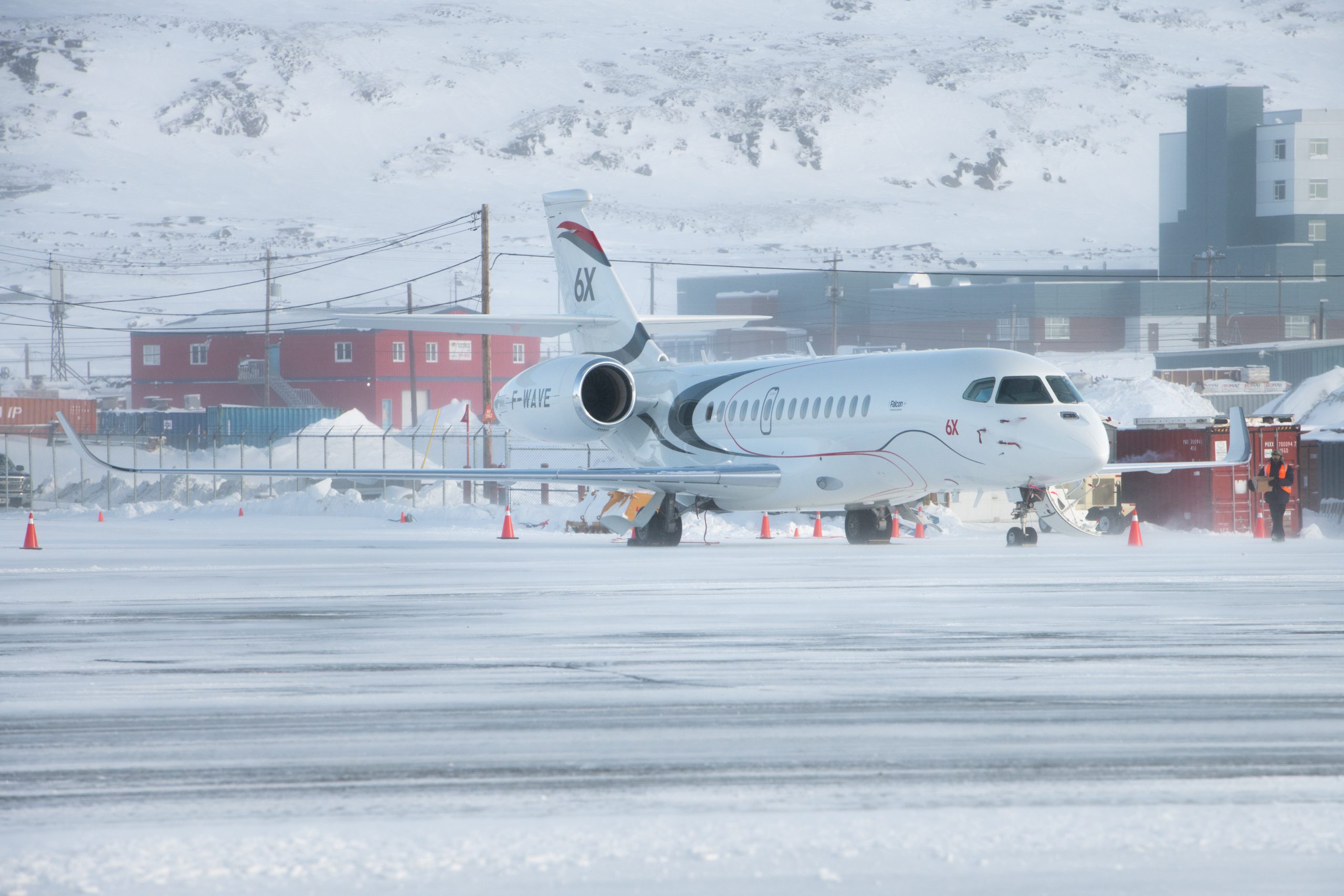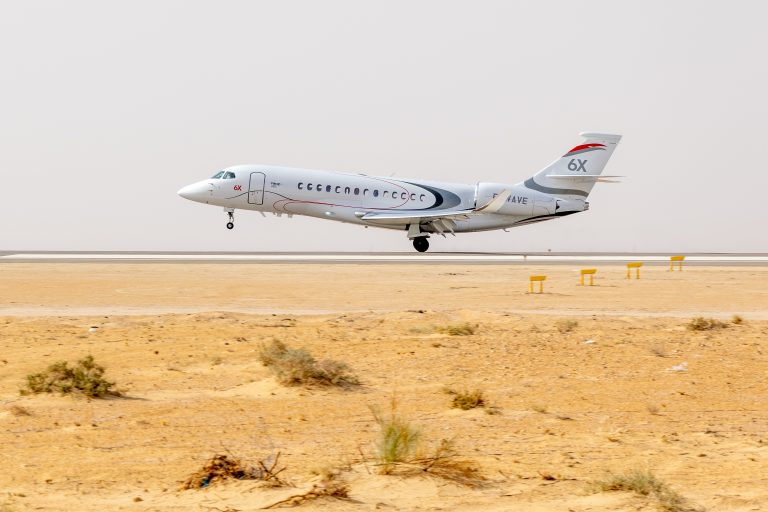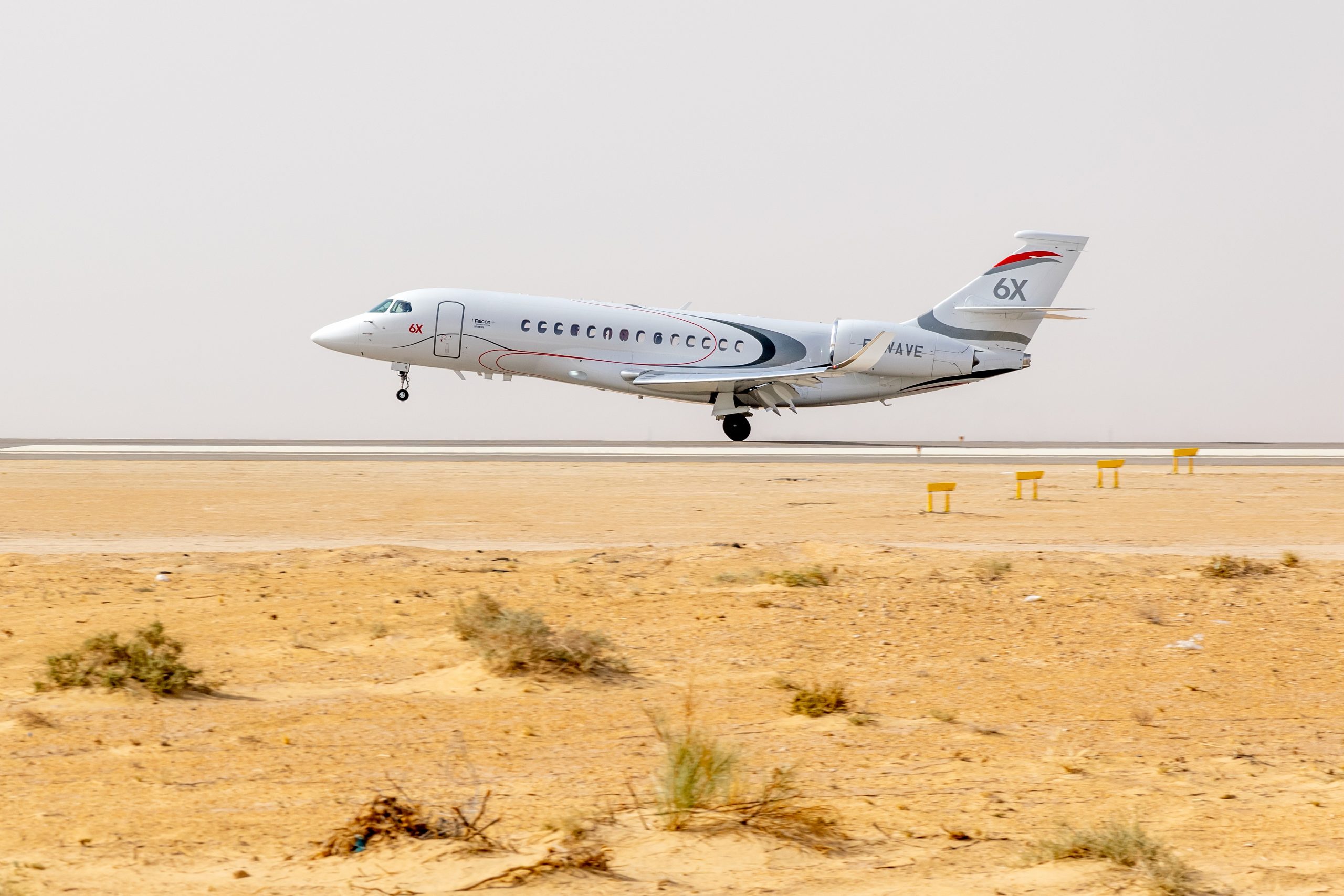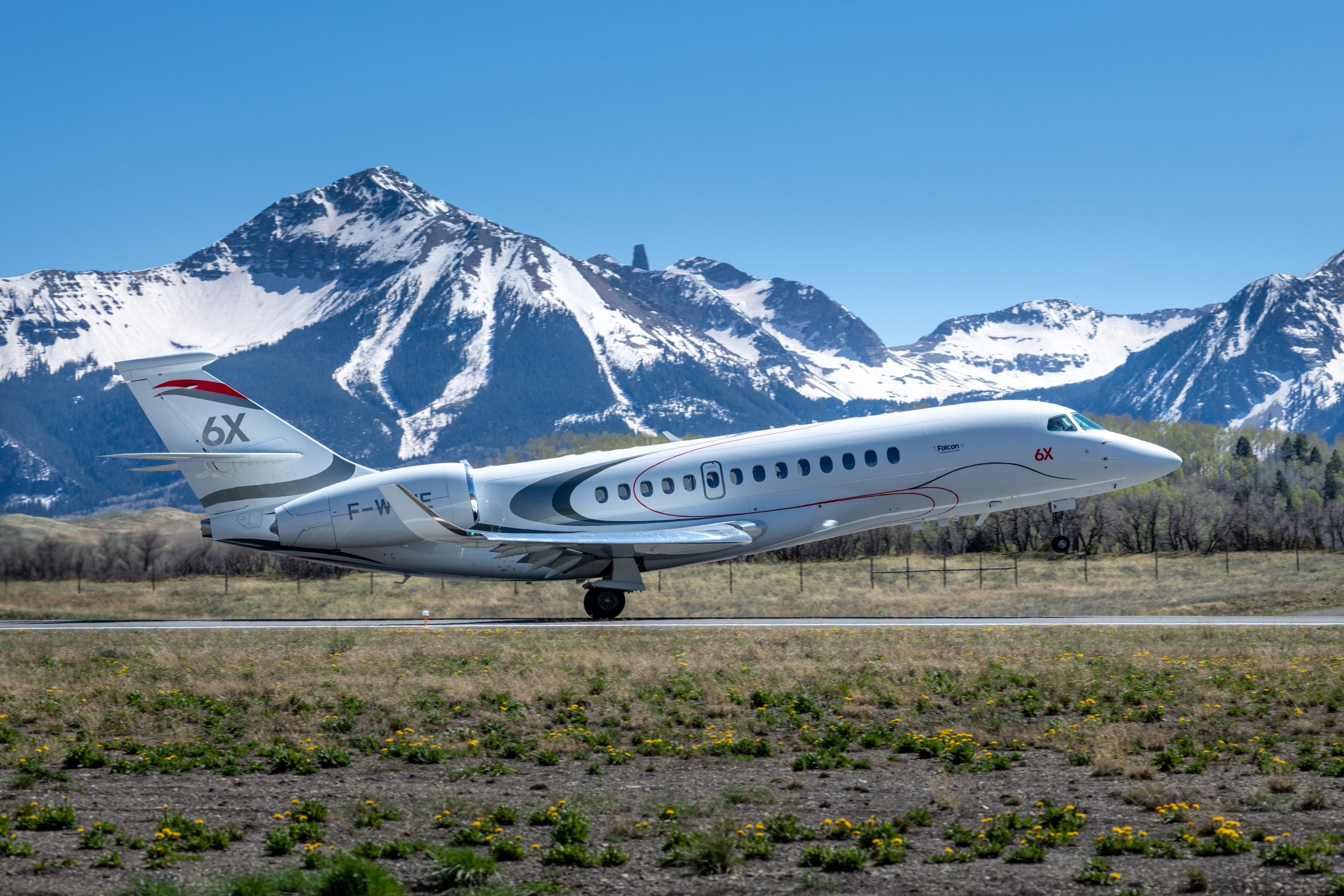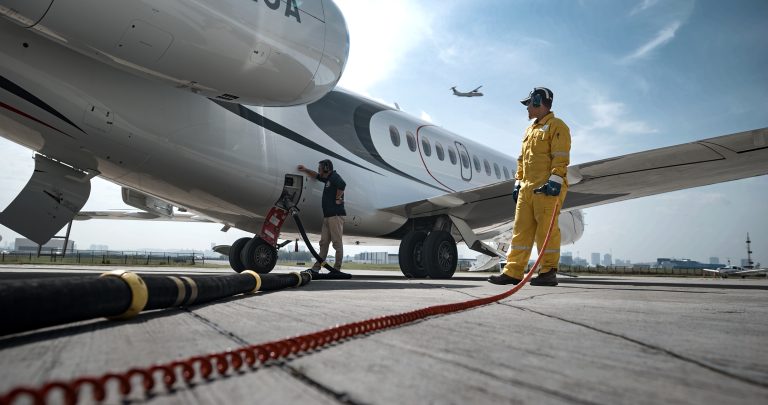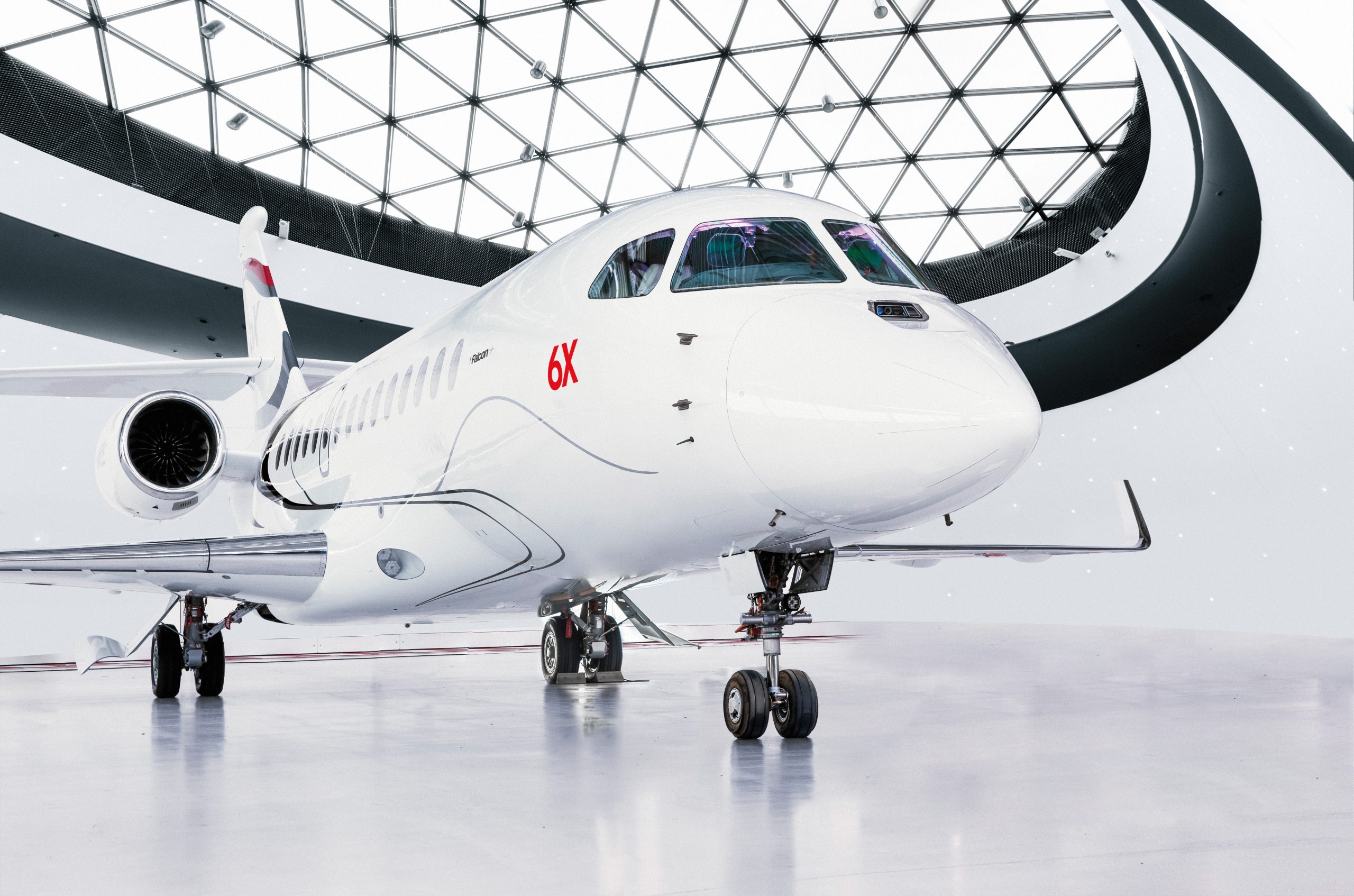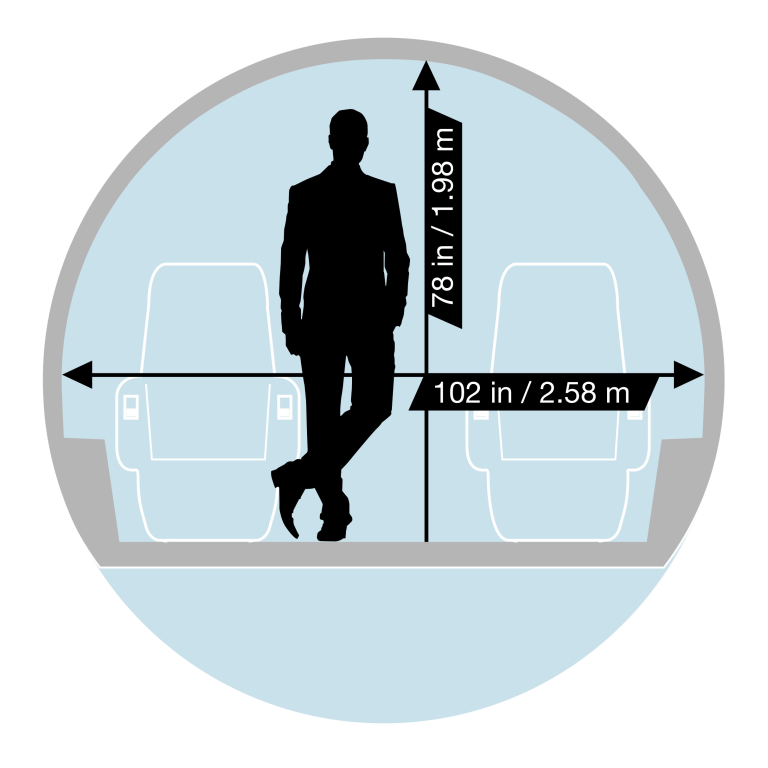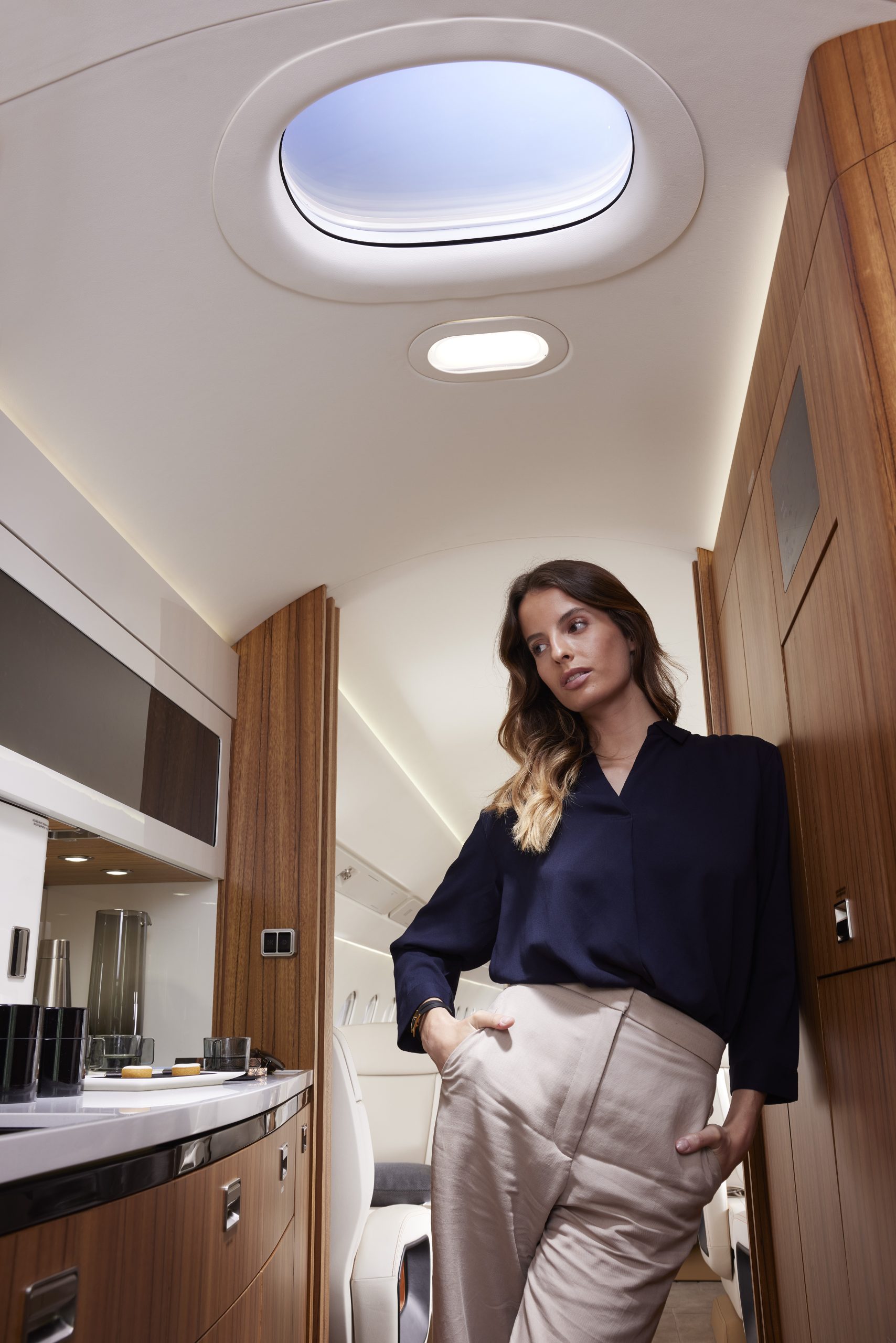A Class All Its Own.
Passenger- and pilot-centric, the Falcon 6X reflects the next step in Dassault’s legendary aircraft heritage.
The Falcon 6X integrates the best features from Dassault Aviation’s world-leading business and fighter aircraft expertise to create the longest-range jet in its class with unparalleled passenger comfort, maximum mission flexibility, and the most advanced cockpit technologies available The Falcon 6X is the most spacious, advanced, and versatile twinjet in the long-range business jet segment.
The aircraft received FAA and EASA certification on August 22, 2023, and entered service on November 30, 2023.
Cabin Space & Amenities
More room to work or relax. Pure comfort for passengers.
The largest cabin – 6 feet 6 inches of headroom and 8 feet 6 inches wide.
The Falcon 6X offers the most interior space in the 5,000 nm segment and features the highest and widest cross-section of any purpose-built business jet.
- Cabin height: 6 feet 6 inches (1.98 meters)
- Max width: 8 feet 6 inches (2.58 meters)
- Cabin length: 40 feet 4 inches (12.30 meters)
All that space translates to room for more personal productivity: for collaborating, for working and for sleeping on long flights.
Thanks to the extra space available, and based on extensive input from customers, Dassault Aviation’s in-house Design Studio completely rethought and restyled the cabin interior. Their solution features flowing, uninterrupted lines that enhance the feeling of spaciousness.
Up to 16 Passengers. Take a large team – there’s room enough to accommodate up to 16 passengers – with individual seating in three separate lounge areas. The extra width also means a 5-inch wider aisle compared to previous Falcons, for more elbow room and easier movement between cabin sections.
Multiple Configurations. Options include an extended entryway and galley, a crew rest area, and a spacious rear stateroom, affording greater privacy when desired, especially on long overnight flights. A new option is the Falcon Privacy Suite with an electrically controlled lie-flat seat.
Large Windows… and a Skylight. The Falcon 6X’s extra-large windows (30 of them) both brighten the cabin naturally and provide unprecedented views, with a total of nearly 5,000 square inches and the highest percentage of window area in its class. Plus, it features an industry-first skylight that provides additional natural light in the galley area.
Quiet and Refreshing. Like the Falcon 8X, the 6X will be the quietest cabin in the sky with interior sound levels below 50 dB. Cabin air is refreshed continuously and processed through hospital-grade HEPA filters to provide added protection against airborne pathogens. “Cabin altitude” pressurization is maintained at a very comfortable 3,950 feet (1204 m), when cruising at 41,000 feet (12,497 m). Passengers not only travel in the most comfortable conditions, they arrive at their destination refreshed and ready for the day.
Connectivity with Style. The 6X cabin comes with high-speed connectivity system solution ensuring seamless in-flight communications and high-speed access to Internet. Connectivity service options include Ka-Band network that allows even faster and more consistent data speed. The cabin also comes equipped with new in-flight entertainment and communications network technology designed to distribute crisp, high-definition audio and video content throughout the cabin. Dassault’s innovative Ambiance cabin management system provides easy fingertip control of cabin environment (temperature, shades, light) plus entertainment on touch panels and personal devices. Passengers can stream audio by Bluetooth from their personal devices to earbuds or cabin speakers.
Speed, Range, Flexibility
More airport options closer to passengers’ final destinations. Maximum mission flexibility. The longest range in its class (up to 5,500 nm) coupled with the short-field takeoff and landing capability typical of the Falcon line.
The Falcon 6X offers the longest range in its class and connects an impressive list of city pairs. Fly almost anywhere in the world and land at airports that are typically inaccessible to large business jets because of short runways or challenging approaches.
Long Range Reach. The Falcon 6X will fly a maximum range of 5,500 nm (10,186 km) at Mach .80 or 5,100 nm (9,445 km) at Mach .85.
Short-Field Capability. With extendable leading-edge slats and trailing-edge flaps on the wings, approach speed can be as low as 110 KIAS (204 km/h) with 8 passengers, 3 crew, SL, NBAA IFR reserves, even on non-standard steep approaches up to 6 degrees. Land at London City, Lugano, Saint-Tropez, Aspen and other challenging airports.
Typical Falcon 6X missions at Long Range Cruise Speed:
- Los Angeles to Geneva
- São Paulo to London
- Beijing to San Francisco
- London to Los Angeles
The Falcon 6X can also perform an impressive list of missions at M .85 including:
- Paris to Beijing
- Shanghai to Melbourne
- Los Angeles to London
- São Paulo to Chicago
- Paris to Johannesburg
Short Hop and Go. The Falcon 6X is able to land with much more fuel than competing aircraft. This allows operators to make a short hop, pick up passengers, and then continue on to an overseas destination without having to refuel. It can fly 50% farther after a short hop compared to its closest competitor. Washington to New York, then to London or Geneva, for example. That’s mission flexibility with economic efficiency.
Ultra-Efficient Wing. The new-generation Falcon 6X wing incorporates advanced structural architecture and curved trailing edge. The increased buffet margin and increased lift/drag ratio reduces the impact of turbulence. While optimized for steep, low-speed approaches to short-field airports, the Falcon 6X can still attain a top cruise speed of Mach .90.
Proven Power. The 13,500 lb PW812D turbofan engine shares the proven, rigorously tested core technology used in Pratt & Whitney’s PurePower® family of geared turbofan commercial engines, with improvements in fuel burn, environmental emissions, engine noise and operating costs for new generation, long-range business jets. The PW812D received transport Canada certification on December 1, 2021 following more than 4,900 hours of testing, including 1,150 hours in flight and 20,000 hours on the engine core. The engine is SAF compatible up to 50 percent and has routinely flown on SAF mixtures during the Falcon 6X flight test program.
The engine delivers double-digit improvement in fuel efficiency, setting a new “green” engine standard for emissions with the advanced TALON™ X combustor, and its low-noise design and low-vibration levels will contribute to reducing cabin noise for a more comfortable passenger experience. The PW812D’s advanced common core technology, employed in 16 different PurePower engine applications, has amassed more than 585,000 in-service hours. From a maintenance perspective, the PW800 engine family sets the industry standard, with 40% less scheduled maintenance than other engines in its class.
RTX Corporation, parent of Pratt & Whitney Canada, provides an integrated power plant solution including inlet, fan cowls, thrust reverser and engine build-up (EBU) system, leveraging lightweight composites to reduce noise and increase fuel efficiency.
The Pilot’s New Office
More control under all flight conditions. Optimized situational awareness for pilots. A more spacious cockpit with larger windows and the next generation of streamlined flight technologies.
The cockpit of the new Falcon 6X will both delight pilots and improve situational awareness.
More Room to Operate. The flight deck has more headroom than any other aircraft and 30% more window space for greater situational awareness in the air and on the ground. The pilot seats recline to 130 degrees, and the broader cockpit allows entry and egress without climbing across the center console. Dassault’s FalconSphere on Ipads are integrated into the console. There’s also more storage space for the flight crew.
Pilots of the 6X will be the first to have access to the new FalconWays route planning app, which can save up to seven percent in fuel and emissions.
The Most Advanced Controls. The next-generation Digital Flight Control System (DFCS) provides better maneuverability and aircraft envelope protection. The DFCS commands all flight control surfaces, including slats and flaps, and each surface is multifunctional for peak performance. The DFCS also integrates nose-wheel steering for safer runway handling in strong crosswinds or on wet runways.
Dassault Aviation introduced digital flight control for business aircraft more than 15 years ago with the launch of the Falcon 7X, leveraging four decades of path-stable, closed-loop auto trim controls for military aircraft. The Falcon 6X represents the next generation of DFCS refinement, further simplifying the pilot’s workload for optimized, safer performance.
Even the streamlined starting sequence for the Falcon 6X is more automated, requiring fewer actions by the pilot other than monitoring the systems as they come online.
Revolutionary Situational Awareness. The FalconEye combined vision system (CVS) will be standard on the 6X. FalconEye is the first Head-Up Display (HUD) to blend synthetic, database-driven terrain imaging and actual thermal and low-light camera images into a single view, providing an unprecedented level of situational awareness to flight crews in challenging weather conditions and all phases of flight. The Enhanced Flight Vision System (EFVS) function provides operational credits for bad weather approaches with 100 ft minimums, with plans to achieve full EFVS-to-land capability in near zero/zero conditions.
The 30×40 degree field of view is one of the widest angles on any HUD, ensuring full viewing coverage with 1280×1024-pixel resolution. FalconEye features a fourth-generation multi-sensor camera whose six sensors present top quality images in both the visible and infrared spectrums. These images are combined with three dedicated worldwide synthetic vision databases that map terrain, obstacles, navigation, and airport and runway data. FalconEye was developed in partnership with Elbit Systems.
Next-Gen EASy. The improved cockpit avionics package includes the latest generation of the EASy system–EASy IV, powered by Honeywell’s Primus Epic platform. EASy IV has more processing power, improving the graphics, color and crispness of displays. It includes new capabilities such as RNP instrument approaches, the ability to display traffic in the air and on the ground, airport moving maps for easier taxiing, optional SiriusXM weather and a Runway Overrun Awareness and Alerting System (ROAAS). EASy IV includes an improved controller-pilot data link communication (CPDLC) system and an automatic 3D color weather radar that provides predictive lightning and hail detection as well as 60 nm range Doppler turbulence detection. Hazardous weather and the vertical definition of thunderstorms can be seen at very long distances.
New Safety Features
More peace of mind. Enhanced safety by design. New flaperons for greater low-speed control. Pressurized fuel tanks. Aircraft health monitoring of thousands of systems and components.
New Flaperon Active Control. The Falcon 6X is the first business aircraft to feature new “flaperons,” active high-speed deflection control surfaces that can act as both flaps (increasing lift) and ailerons (roll control). Integrated into the DFCS, flaperons are especially beneficial during approaches with a steep descent profile, increasing drag while maintaining a high-lift coefficient.
Pressurized Fuel System. Fuel tank pressurization has long been a feature on Falcons to reduce the risk of ignition in fuel tanks. But the Falcon 6X is the first business aircraft to use a nitrogen-generating system to fill the space above remaining fuel with an inert gas, providing a higher level of protection against ignition.
Cutting Edge Tools and Value
Monitoring 100,000 Parameters. A new onboard integrated maintenance system, FalconScan, sets a new industry standard in real-time system self-diagnosis. Connecting directly to all aircraft systems, FalconScan monitors more than 100,000 parameters (compared to hundreds on previous Falcons), providing visibility for the on-ground maintenance team. Patented algorithms will enable fault detection and troubleshooting for individual aircraft plus trend monitoring across the Falcon 6X fleet worldwide.
Reduced Maintenance Cost. The current fleet of more than 2,100 Falcons operated in 90+ countries fully demonstrates the exceptional strength of the Falcon models. Unlike some of their competitors, Falcons do not have any life-limited primary structural parts. Dassault’s FalconCare guaranteed maintenance cost program assures budgeting predictability related to parts, labor and AOG onsite service. Falcon 6X maintenance intervals will be extended in accordance with the latest MSG3 standards, further improving aircraft availability. The 6X will be guaranteed for 800 hours or 12 months between inspections – intervals 30% longer than previous-generation aircraft.
Falcon 6X Milestones
- Test flights: March 10, 2021
- FAA and EASA certification: August 22, 2023
- Entry into service: November 30, 2023
Falcon 6X certification followed a 1,500-hour flight test program with three aircraft. The fourth production aircraft, outfitted with a full interior, also completed a 50-stop, 50,000 nm proving campaign prior to certification.
Falcon 6X Specifications
PERFORMANCE
- Range: 5,500 nm (10,186 km) at Mach .80 (8 pax, 3 crew, ISA, SL, Zero Wind, NBAA IFR Reserves); 5,100 nm (9,445 km) at Mach .85
- Maximum Mach Operating (MMO) speed: Mach .90
- Maximum Certified Altitude: 51,000 ft (15,545 m)
- Balanced Field Length (MTOW; SL; ISA): 5,115 ft (1,560 m)
- Approach Speed, Vref (8 pax, 3 crew, SL, NBAA IFR Reserves): 110 kias (204 km/h)
- Landing Distance (SL): 2,440 ft (744 m)
ENGINES & AVIONICS
- 2 Pratt & Whitney PW812D
- Max Thrust (20°C flat rated): 13,500
- EASy III Flight Deck
- With Honeywell Primus Epic System
EXTERNAL DIMENSION
- Wing Span: 85 ft 1 in (25.94 m)
- Length: 84 ft 3 in (25.68 m)
- Height: 24 ft 6 in (7.47 m)
INTERNAL DIMENSIONS
- Cabin Height: 6 ft 6 in (1.98 m)
- Cabin Width: 8 ft 6 in (2.58 m)
- Cabin Length (excluding flight deck and baggage): 40 ft 4 in (12.30 m)
- Cabin Volume (excluding flight deck and baggage): 1,843 ft3 (52.2 m3)
- Baggage Volume: 155 ft3 (4.4 m3)
WEIGHTS/CAPACITIES
- Maximum Ramp Weight: 77,900 lb (35,335 kg)
- Maximum Takeoff Weight: 77,500 lb (35,153 kg)
- Maximum Landing Weight: 66,200 lb (30,028 kg)
- Maximum Zero-Fuel Weight: 45,900 lb (20,820 kg)
- Maximum Fuel Weight: 33,800 lb (15,331 kg)



